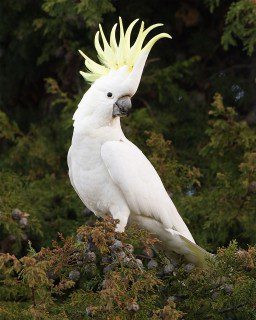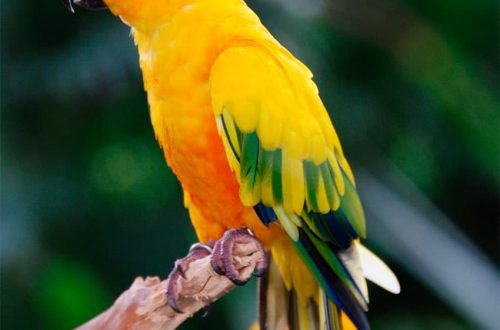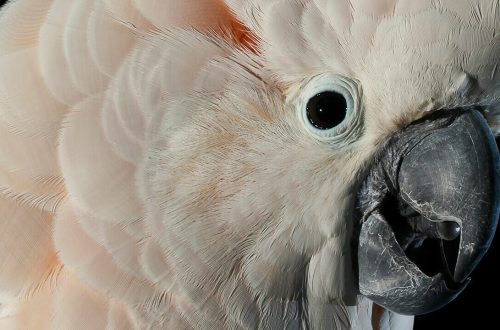
Cockatoo (Cacatua)
Order | Parrots |
family | Cockatoo |
Contents
APPEARANCE
Body length: 30 – 60 cm, weight: 300 – 1200 gr.
The tail of the cockatoo is short, slightly rounded or straight cut.
The coloration of males and females is the same, but they differ in size (females are slightly smaller). The color of the plumage depends on the type of cockatoo.
Distinguishing feature: crest (elongated feathers on the back of the head and crown). When the cockatoo is excited, he willingly demonstrates the crest, unfolding it like a fan and attracting the attention of relatives. The color of the crest differs from the general color of the plumage. It may consist of yellow, pink, black or white feathers. The green color is missing completely.
The beak of the cockatoo is massive, long and curved. Characteristic features that distinguish these birds from other parrots: the mandible is wider than the mandible, if we compare the widest part, and therefore the edges of the mandible are superimposed on the mandible like a ladle. Such a beak arrangement is characteristic only of cockatoos.
The beak of the cockatoo is powerful. He is able to “bite” not only the bars of the cage made of wood, but also soft wire. And in nature, it is able to easily split the hard shells of various nuts.
The cere may be naked or feathered – it depends on the species.
The tongue is fleshy, its tip is covered with a black cornea. The parrot uses the hollow in the tongue like a spoon.
HABITAT AND LIFE IN NATURE
Cockatoos live in New Guinea, Australia and many Pacific islands. The life expectancy of these birds in the wild is up to 70 years.
Crow cockatoos live in the rainforests of Tasmania and Australia. White-eared cockatoos are native to southwestern Australia. Yellow-eared cockatoos live in eastern or southeastern Australia. Australia is the birthplace of the bearded, or noble, cockatoo. And the black, or ararovid, cockatoo has chosen the north of Australia and New Guinea, lives alone or forms small groups. Home for yellow-cheeked cockatoo – the islands of Sulawesi and Timor. Moluccan (red-crested) cockatoos live in the Moluccas. Spectacled cockatoos are native to the Bismarck Islands. The Solomon cockatoo lives in the Solomon Islands. Large yellow-crested cockatoos inhabit the northeast and east of Australia and New Guinea. Small yellow-crested cockatoos live in the Lesser Sunda Islands and Sulawesi. Orange-crested cockatoos are common on the island of Sumba. Large white-crested cockatoos live on the islands of Halmahera, Ob, Ternate, Batyan and Tidore, as well as on the Moluccan archipelago. The bare-eyed cockatoo is native to Australia. As, however, and pink cockatoos. The Inca cockatoo prefers to live in the eastern and central parts of Australia. Philippine cockatoos inhabit the island of Palawan and the Philippine Islands. The Goffina cockatoo lives on the Tanibar Islands. And two species of nosed cockatoos are found in Australia.
Parrots fly so-so, but they climb trees perfectly. And on the ground, most of these birds move very cleverly.
KEEPING IN HOME
Character and temperament
Cockatoos are funny and interesting parrots, which makes them desirable pets. They are not very talkative, but they can learn several dozen words or even phrases, and also make a variety of sounds.
Cockatoos are perfectly tamed, unusually attached to the person who cares for them. But if they are dissatisfied with something, they begin to shout loudly, they can be capricious. And if you offend them, they will remember for a long time.
They can learn many fun tricks and even perform in the circus.
These birds are distinguished by the ability to open shutters and locks, so you should be vigilant.
They need a lot of attention. If communication is lacking, the cockatoo demands it with loud cries. If you leave for a long time, you should leave the TV or radio on.
Cockatoos are active, love to play and need constant mental and physical stress. Therefore, it is worth buying a variety of toys in large quantities (ropes, ladders, perches, bells, branches, etc.). Toys for large parrots are also sold in pet stores.
Do not leave a cockatoo unattended with a small child or other pet.
Maintenance and care
A metal cage or aviary is suitable for keeping a cockatoo, the rods must be horizontal, have a diameter of 3 mm. The distance between the bars should not exceed 2,5 cm.
Choose a padlock, as the cockatoo can handle other types of deadbolts with ease.
It is better if the top of the aviary or cage is domed.
The bottom is lined with a material that absorbs moisture well.
Clean the feeder and drinker daily. Wash (if dirty) toys and perches. Wash and disinfect the cage every week, the aviary every month. Clean the cage floor twice a week. The bottom of the cage is cleaned daily.
There should be a swimsuit in the aviary or cage – cockatoos love water treatments. You can spray a feathered friend from a spray bottle.
Equip the cage with several perches (minimum length – 20 – 23 cm, diameter – 2,5 – 2,8 cm) and hang them at different levels. Moreover, one of the perches should be located near the drinkers and feeders (but not above them).
It is also desirable to bring variety in the form of ropes and ladders.
Feeding
Drinkers and feeders (3 pieces, steel or ceramic) should be stable and heavy.
Cockatoos are not picky about food, the main food is a special grain mixture. They are also happy to treat themselves to vegetables or herbs. Cockatoos should not be given fried foods, salt, dairy products (with the exception of yogurt), sugar, alcohol, parsley, chocolate, avocados, and coffee.
Be sure to provide the cockatoo with access to the branches of fruit trees.
Adult parrots are fed twice a day.
Fresh water should always be available. Change it when it gets dirty.
Breeding
If you want to breed a cockatoo, a couple must be placed in a room where there are 2 adjacent enclosures: an external one and an insulated internal one.
An important condition: the humidity of the air must be at least 80%. If the room is dry, the shell dries up, its gas permeability decreases, and the embryo dies.
The nesting house needs a small one (34x38x34 cm), made of thick (multi-layered) plywood. Notch size: 10×12 cm. Sawdust is poured into the bottom.
The clutch usually contains 2 eggs. Incubation lasts 30 days.
Both parents take care of the chicks in the same way. The younger generation leaves the nest at about 1,5 months with an interval of 6-7 days.





